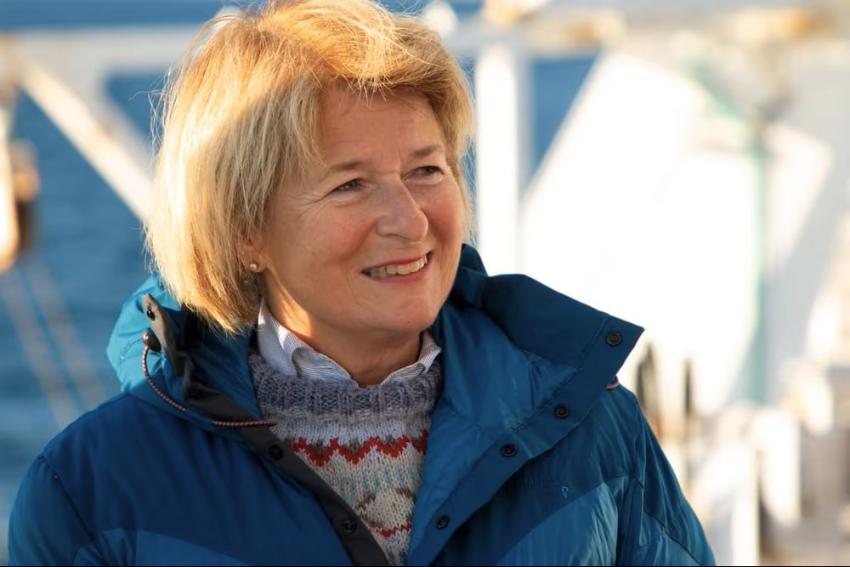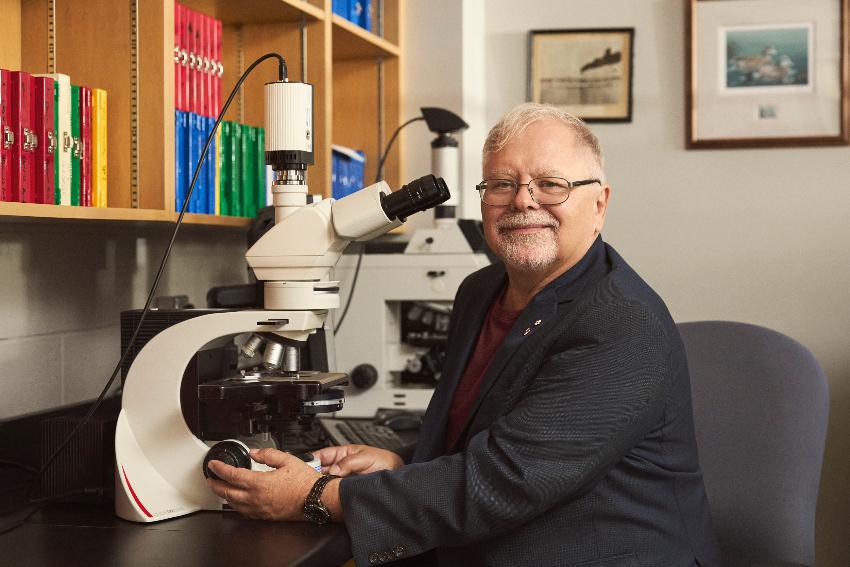Future Pathfinders in the Arctic
At the beginning of August, the sailing ship Statsraad Lehmkuhl will depart from the quay in Nuuk, Kalaallit Nunaat, to sail through the Northwest Passage with students and researchers from UiT The Arctic University of Norway. The associations one might have when seeing a full-rigged ship in these waters are, unfortunately, not necessarily positive.

Most people probably know Kalaallit Nunaat better as Greenland, and few of us question that name.
The European way of narrating world history has traditionally been that it was Europeans who "discovered" other countries, defined them, conquered them, and gave them names. The Norwegian-Icelandic Erik the Red was the first European to explore the west coast of Kalaallit Nunaat.
He named the island Greenland, supposedly reasoning that people would be more inclined to travel there if the land had an appealing name.
However, the first inhabitants settled there around 4,500 years ago, long before Erik the Red "discovered" and named the land. And unlike Erik the Red, it is likely that the first humans arrived on the world's largest island from the west. The oldest human remains have been found on the west coast, in the area we now know as Disko Bay, at Saqqaq settlements dating back to approximately 2400 BCE.
The legacy of Amundsen
The Statsraad Lehmkuhl is far from the first sailing ship to traverse the entire Northwest Passage. The passage, which runs along the northern coasts of Canada and Alaska, has become iconic in polar history due to European, and particularly British, attempts to find this mythical sea route to the Orient.
It was ultimately Roald Amundsen and his crew who, during the Gjøa Expedition from 1903 to 1906, became the first to sail all the way through. This is a heroic tale that we Norwegians, in particular, have grown up with, coinciding with a young nation's need to build identity and national pride—though less emphasis has been placed on how the expedition was perceived by the Indigenous peoples of the area, either then or in more recent times.
It should be noted, however, that Amundsen himself is an example of an explorer who demonstrated both kindness and deep respect for the local Inuit, establishing a mutually beneficial relationship with the Inuit in Gjøa Haven. But the history of Europeans in the Northwest Passage is long, and it includes many examples of approaches quite different from Amundsen's.
The associations one might have when seeing a full-rigged ship in the waters we will sail through in August and September are therefore not necessarily positive. Even though the first inhabitants of Kalaallit Nunaat arrived via the Northwest Passage some 4,500 years ago, it is the many European expeditions that have garnered the most attention.
The word "expedition" means "a major journey" and is used to describe travels requiring significant equipment for a specific purpose, such as scientific or military objectives. There is something imperialistic about the word that is hard to ignore.
Of course, this is not to say that the word itself is problematic, nor the type of vessel, but in light of a history we should not uncritically take pride in, we must be aware that such a voyage may evoke unwanted associations.
Read also: “We must change to be able to decolonize”
Theory and practice
Here we stand at the heart of the challenges we have faced while planning our own voyage: What has really changed since Amundsen sailed through and an entire nation celebrated his achievement?
UiT The Arctic University of Norway has been at the forefront in supporting the criticism presented in the Truth and Reconciliation Commission's report, and we see it as a given to contribute to the subsequent work. Many academic communities at UiT are working hard to strengthen efforts to create and share better relations and knowledge for and about the Sámi and Kven/Norwegian-Finnish communities. However, we also recognise that even at UiT, there can be a gap between theory and practice. During the planning of the voyage, we have more than once found ourselves unintentionally making mistakes because we have failed to fully grasp the depth of what is outlined in the report.
Our purpose for the voyage through the Northwest Passage is, however, very clear: to provide the participating students with an international perspective, rooted in everything from local communities to global climate perspectives.
When educating young people to become future polar researchers and knowledge bearers, we must give them a solid foundation and, above all, teach them to understand and respect Arctic culture and history.
In a world that is becoming increasingly divided, we are planning a student course centred on global unity, development, and reconciliation. We are bringing together an international group of 120 young people on a sailing ship, a significant proportion of whom have roots in Arctic Indigenous communities. Together with researchers and educators from UiT, as well as representatives from the local communities we visit, the participants will create knowledge and shared experiences.
In an interdisciplinary setting, they will jointly analyse environmental changes and socio-economic impacts from the past, identify future drivers, and discuss possible scenarios for the Arctic.
Read also: "We must balance innovation with cultural heritage"
Pathfinders of tomorrow
The Arctic is facing significant and dramatic changes, much of which is related to accelerating climate change, impacting ecosystems, local communities, and traditional ways of life. As sea ice melts, new transport routes open, questions about resource extraction become more pressing, and international interest grows. Additionally, technological development, migration, tourism, demographics, and geopolitics make the future of Arctic socio-political systems and natural environments highly uncertain.
Many organisations have created visions for the future of the Arctic, but it remains a challenge to fully explore the range of possibilities for the changes that may come. Imagining this range is crucial for preparing for the future, promoting sustainable development, preserving ecosystems, and empowering Indigenous peoples and local communities.
We want our students to be able to develop innovative and adaptable solutions to future challenges. In this way, they can become new pathfinders for the Arctic of tomorrow—not like the historical pioneers who arrived with various intentions, including exploration and resource exploitation, but with humility and respect, aiming to create a shared global vision for the future. This vision will be rooted in the local and guided by the worldviews, knowledge systems, and cosmologies of Arctic peoples, shaped over generations in harmony with nature.
It is our sincere hope that the planning and execution of this voyage will provide valuable lessons for the institution and for us as staff, and that together we can use this opportunity to take meaningful steps in the direction the Truth and Reconciliation Commission has so earnestly urged the entire nation to pursue.
-
Fiskeri- og havbruksvitenskap - bachelor
Varighet: 3 År -
Fiskeri- og havbruksvitenskap - master
Varighet: 2 År -
Akvamedisin - master
Varighet: 5 År -
Arkeologi - master
Varighet: 2 År -
Peace and Conflict Transformation - master
Varighet: 2 År -
Computer Science - master
Varighet: 2 År -
Geosciences - master
Varighet: 2 År -
Biology - master
Varighet: 2 År -
Technology and Safety - master
Varighet: 2 År -
Law of the Sea - master
Varighet: 3 Semestre -
Biologi - bachelor
Varighet: 3 År -
Nordisk - årsstudium
Varighet: 1 År -
Historie - årsstudium
Varighet: 1 År -
Luftfartsfag - bachelor
Varighet: 3 År -
Pedagogikk - bachelor
Varighet: 3 År -
Arkeologi - bachelor
Varighet: 3 År -
Pedagogikk - master
Varighet: 2 År -
Informatikk, datamaskinsystemer - bachelor
Varighet: 3 År -
Informatikk, sivilingeniør - master
Varighet: 5 År -
Allmenn litteraturvitenskap - årsstudium
Varighet: 1 År -
Likestilling og kjønn - årsstudium
Varighet: 1 År -
Historie - bachelor
Varighet: 3 År -
Geovitenskap- bachelor
Varighet: 3 År -
Kjemi - bachelor
Varighet: 3 År -
Samfunnssikkerhet - bachelor
Varighet: 3 År -
Samfunnssikkerhet - master
Varighet: 2 År -
Kunst - bachelor
Varighet: 3 År -
Kunsthistorie - master
Varighet: 2 År -
Farmasi - master
Varighet: 2 År -
Religionsvitenskap - årsstudium
Varighet: 1 År -
Romfysikk, sivilingeniør - master
Varighet: 5 År -
Klima og miljøovervåkning, sivilingeniør - master
Varighet: 5 År -
Sosialantropologi - bachelor
Varighet: 3 År -
Bærekraftig teknologi, ingeniør - bachelor
Varighet: 3 År -
Historie - master
Varighet: 2 År -
Filosofi - bachelor
Varighet: 3 År -
Barnehagelærer - bachelor
Varighet: 3 År -
Anvendt fysikk og matematikk, sivilingeniør - master
Varighet: 5 År -
Barnevernsarbeid - master
Varighet: 2 År -
Forfatterstudium 2 - årsstudium
Varighet: 1 År -
Organisasjon og ledelse for offentlig sektor - erfaringsbasert master
Varighet: 3 År -
Fine Art - master
Varighet: 2 År -
Barnevern - bachelor
Varighet: 3 År -
Arctic Nature Guide - one year programme
Varighet: 1 År -
Sosialt arbeid - bachelor
Varighet: 3 År -
Arktisk friluftsliv og naturguiding - bachelor
Varighet: 3 År -
Arktisk friluftsliv - årsstudium
Varighet: 1 År -
Grunnskolelærerutdanning for 1.-7. trinn - master
Varighet: 5 År -
Kunsthistorie - årsstudium
Varighet: 1 År -
Governance and Entrepreneurship in Northern and Indigenous Areas - master
Varighet: 4 År


